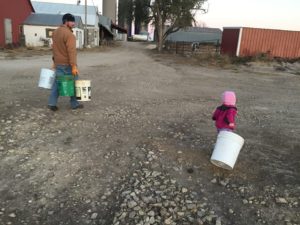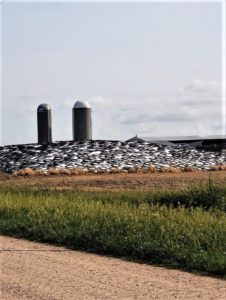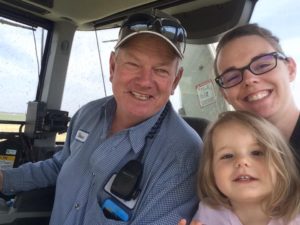From the Farm:
Ohlde Dairy: Cows, Family and Corn Silage
By Deb Ohlde, Central Region and Grower Services Coordinator

Reagan, helping her dad Justin with chores at the dairy.
The silos at Ohlde Dairy are empty now, replaced with covered silage piles; a key part of the ration for the nearly 1300 cows they currently milk. This is only one of many changes that they’ve experienced over the years as they’ve moved through three generations of family in the operation. Three and a half might be more accurate. The fourth generation is just getting started helping with chores and riding in the silage chopper, she’s only 2 after all.
Ohlde Dairy was started by Bob and Norma Ohlde in 1955, and one of their five children, Steve and his wife Cindi joined the operation 25 years later. Currently three of their four sons, Justin and wife Becky, Levi and Kyler are also partners. Justin’s daughter Reagan is generation 4.0.
Corn is a key component in the Total Mixed Ration at Ohlde Dairy while dry distiller grains (DDGS) play a supporting role according to Justin Ohlde, “Our ration is corn heavy. We grow all our corn with the intention of harvesting it as silage.”

Corn silage pit at Ohlde Dairy. The pit is covered with a large tarp and tires to protect the feed from the elements and trap heat and moisture for the natural fermenting process.
But that doesn’t mean yield isn’t important. They still look for high bushels per acre to enhance the quality of the feed. However, they do choose seed varieties in search of a different plant profile.
“We actually want a plant with less lignin and a softer kernel with more starch. Pretty much a 180-degree difference from a typical corn farmer in the Midwest.” he said. Corn genetics are important to them as they strive for the best yield in an area with variable rainfall. They maximize moisture with no-till and cover crops on their land in Washington County.
A fleet of choppers and silage trucks are used to ensure silage is harvested at peak quality.
“Timing is critical to having the highest quality feed for the cows which in turn maximizes milk production,” according to Justin. Research on chop length and digestibility impacts their approach to growing silage. The family recently formed a separate company that also uses the cutters and trucks to do custom chopping for other farmers.
Justin’s family looks for opportunities to tell their story and hosts tours on the farm. Their annual open house is coming up June 23rd. They recognize consumers make choices about what to eat and the source of their food. The market should respond to those choices, but Justin believes farmers have an obligation to make sure they are based on truthful information.
“Too often controversial topics like GMOs or antibiotics in milk get lumped together into a big category and cast in an almost evil light,” he said. “We need to explain the role of these tools to consumers to help them understand the real story behind how we produce food.“

Three generations of Ohlde Dairy farmers riding in the silage chopper; Steve, Becky and Reagan Ohlde.
He offered the example of consumers desiring grass fed alternatives by noting that corn is a grass and as the entire stalk is used in the ration, the animals are being grass fed along with the grain. Cows are also a great “recycler”. They take feed off the field, and then the manure they generate goes back on the field to continue the cycle. Their commitment to no-till farming does require the use of herbicide and pesticide, but the environmental benefits of reduced erosion, runoff and lower fuel usage balance that out.
Farming is a business, but also a lifestyle choice with the advantage of wide-open space, interacting with nature and working together as a family. Farming with multiple generations offers the balance of experience and new ideas. Ohlde Dairy is working hard to make sure that same opportunity is there for the fourth generation and future generations to also be involved.
